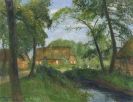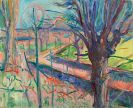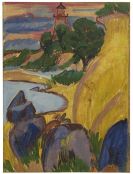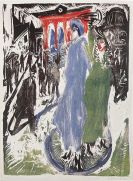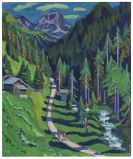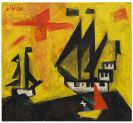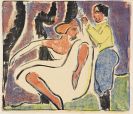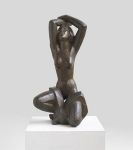
Otto Modersohn
Soest
1865 -
Fischerhude
1943
In 1884 the Modersohn family moved from Soest to Münster. During his time at secondary school Otto Modersohn developed a keen interest in art. After graduating from secondary school Otto Modersohn went to the Düsseldorf academy, but he did not agree with the teaching methods used there. After a short sojourn in Munich Otto Modersohn hoped to find artistic role inspiration at the Karlsruhe academy, but once again he was disappointed.
A trip through northern Germany with Mackensen in 1888 on the other hand inspired Otto Modersohn to a series of smaller pictures. These form a first highlight of his early years. A further trip of the two aritsts to Worpswede in 1889 lead to the joint decision to move to the artists' colony for good. After initially sharing the same ideas, Otto Modersohn gradually began to move away from his friends. He wrote: "Quiet, quiet greatness is really my actual goal," and he would rather "say much by saying little[...]."
In 1895 eight of Modersohn's works entered the joint exhibition of the Worpsweder art colony at the Bremen "Kunsthalle". The reactions to this exhibition were varied, but the subsequent contributiuon to the "Internationale Glaspalastausstellung" in Munich was particularly successful for Modersohn.
In 1897 Paula Becker visited Worpswede for the first time. In 1901 Otto Modersohn and Paula Becker married. Meanwhile Otto Modersohn was thinking more and more about leaving the colony. The time that followed was determined by numerous travels with his wife and various sojourns in Germany and France. In spring 1907 Modersohn finally returned to Worpswede. Paula Modersohn died there in November of the same year after the birth of their daughter.
Otto Modersohn moved to Fischerhude, where 1908 marked the beginning of "a new era" for Modersohn. In this rural environment, Modersohn studied nature and after renewed sojourns in Worpswede and Berlin he returned here in 1917. "Simplification, summarization in form and color is a main aim" of his artwork during the 1920s. Hence Modersohn found important inspiration in Holland and the southern German region of Allgäu, where he bought a house in 1930.
In 1936 he turned blind on one eye. Subsequently, he stoped visiting the Allgäu and continued only to paint in his studio in Fischerhude.
In 1943 Otto Modersohn died after a short, unexpected illness.
Would you like to sell a work by Otto Modersohn?
Infos for seller
